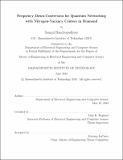| dc.contributor.advisor | Dirk R. Englund. | en_US |
| dc.contributor.author | Bandyopadhyay, Saumil | en_US |
| dc.contributor.other | Massachusetts Institute of Technology. Department of Electrical Engineering and Computer Science. | en_US |
| dc.date.accessioned | 2018-12-11T20:39:31Z | |
| dc.date.available | 2018-12-11T20:39:31Z | |
| dc.date.copyright | 2018 | en_US |
| dc.date.issued | 2018 | en_US |
| dc.identifier.uri | http://hdl.handle.net/1721.1/119544 | |
| dc.description | Thesis: M. Eng., Massachusetts Institute of Technology, Department of Electrical Engineering and Computer Science, 2018. | en_US |
| dc.description | This electronic version was submitted by the student author. The certified thesis is available in the Institute Archives and Special Collections. | en_US |
| dc.description | Cataloged from student-submitted PDF version of thesis. | en_US |
| dc.description | Includes bibliographical references (pages 49-54). | en_US |
| dc.description.abstract | Quantum frequency conversion (QFC) devices are critical to building long-distance quantum networks, which would connect quantum memories located at distant nodes through optical channels for efficient entanglement distribution. The nitrogen-vacancy (NV) center in diamond is an attractive candidate for these memories because of its long coherence time and the ability to optically write to and read out information from its spin. However, the NV-center fluoresces in the visible range, which experiences strong losses (8 dB/km) in optical fiber and has limited the current distance record for entanglement between two NVs to 1.3 km. Using difference frequency generation, we demonstrate a free-space quantum frequency conversion system that could be used to convert photons emitted by the NV to 1080 nm. This thesis reports the building and characterization of the system, which demonstrates exceptionally high signal-to-noise ratio (SNR). While not as optimal as conversion to the telecom C-band, losses at 1080 nm are significantly lower (<2 dB/km), and along with the system's high SNR, should enable much longer distance entanglement experiments than previously achieved. | en_US |
| dc.description.statementofresponsibility | by Saumil Bandyopadhyay. | en_US |
| dc.format.extent | 54 pages | en_US |
| dc.language.iso | eng | en_US |
| dc.publisher | Massachusetts Institute of Technology | en_US |
| dc.rights | MIT theses are protected by copyright. They may be viewed, downloaded, or printed from this source but further reproduction or distribution in any format is prohibited without written permission. | en_US |
| dc.rights.uri | http://dspace.mit.edu/handle/1721.1/7582 | en_US |
| dc.subject | Electrical Engineering and Computer Science. | en_US |
| dc.title | Frequency down-conversion for quantum networking with nitrogen-vacancy centers in diamond | en_US |
| dc.type | Thesis | en_US |
| dc.description.degree | M. Eng. | en_US |
| dc.contributor.department | Massachusetts Institute of Technology. Department of Electrical Engineering and Computer Science | |
| dc.identifier.oclc | 1076272686 | en_US |
